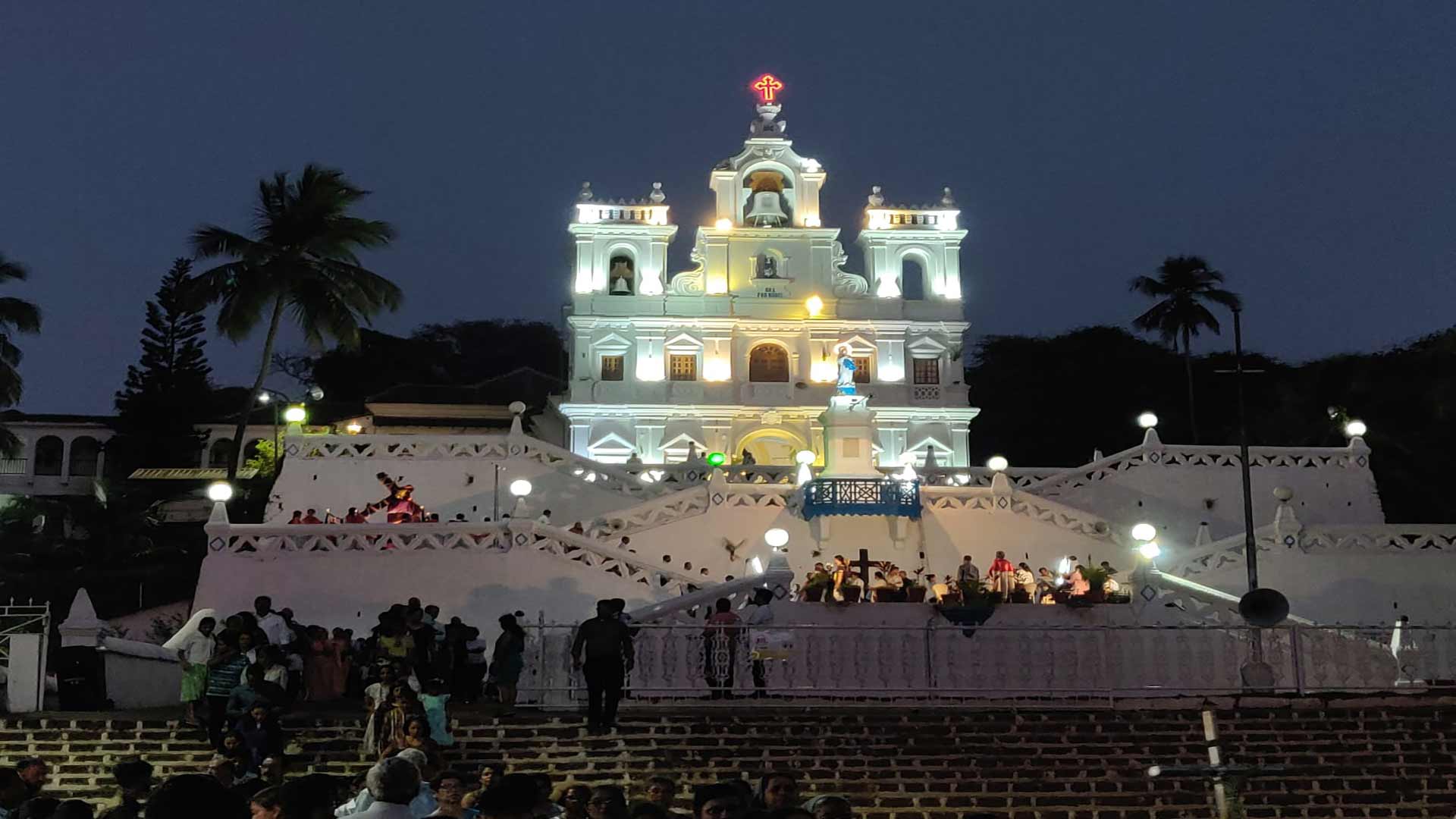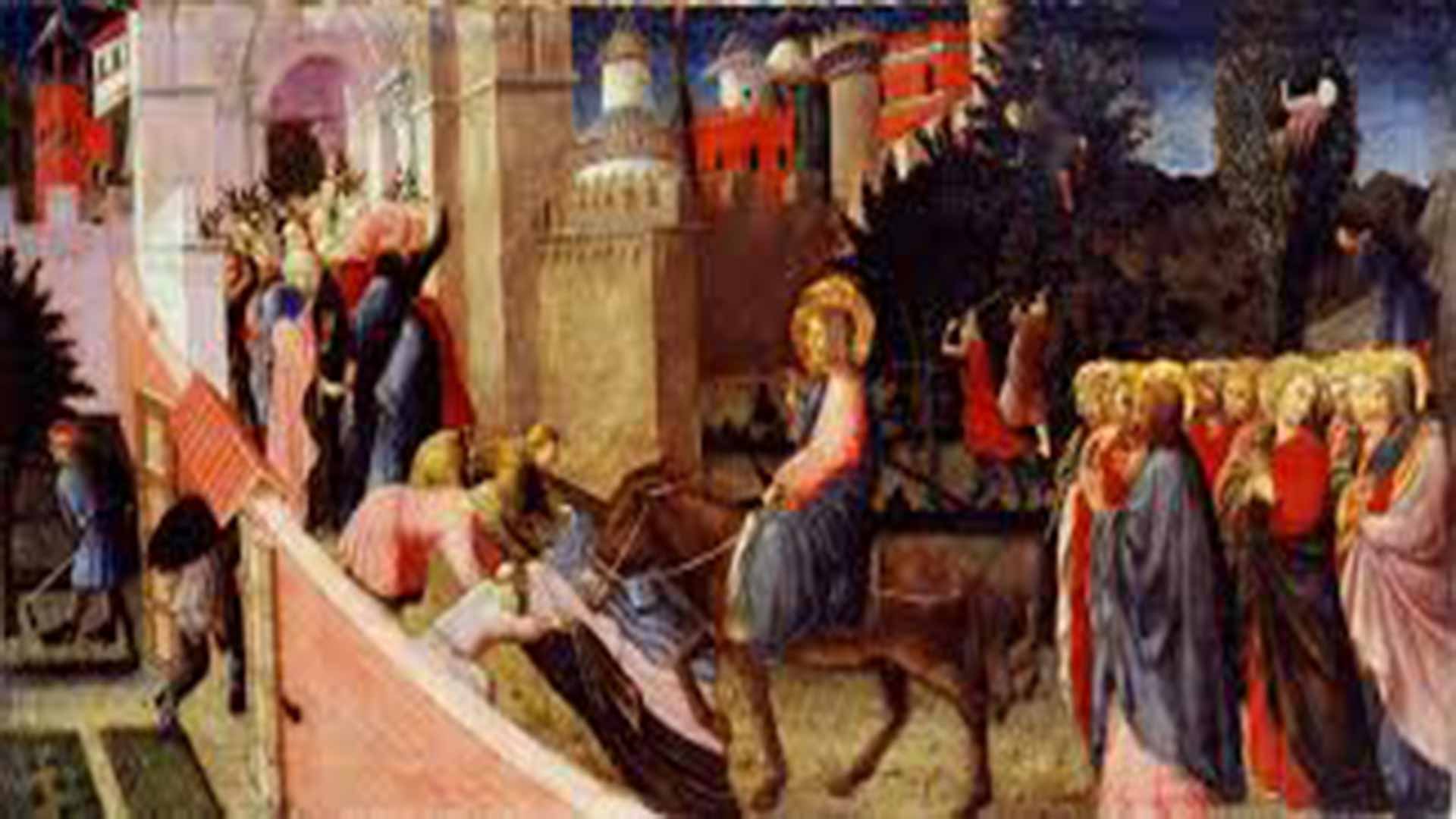Holy Passion Processions in Panjim
At the Church of the Immaculate Conception – the Igreja Matriz or main parish church of Panjim – the sixth Sunday of Lent begins on a festive note. It is Palm Sunday, which commemorates the triumphant entry of Jesus in Jerusalem.
However, after the morning Masses, there is a visible change in the mood, especially with the unveiling of the tableau in the chancel: a larger-than life-size statue of Christ carrying the Cross. Hence, the day's alternative designation: Passion Sunday.
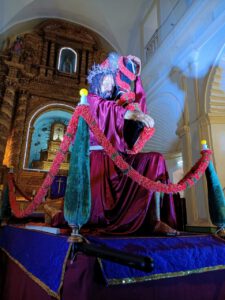
The evening of Passion Sunday features a solemn procession that begins from and ends at the iconic church. It is the highpoint of the Santos Passos (‘Holy Steps’) held on the first five Sundays of Lent, highlighting some of the most intense moments of Christ’s Passion leading to Calvary: the Agony in the Garden of Gethsemane; the Arrest of Jesus; the Flagellation at the Pillar; the Crowning with Thorns; the condemnation by Pontius Pilate (See my blogpost https://www.oscardenoronha.com/2019/03/17/santos-passos-in-panjim/ ). Other churches in Goa do not necessarily have the same set-ups (See https://www.oscardenoronha.com/2021/03/21/lenten-traditions-in-goa/ ).
Passion Sunday signals the beginning of the Holy Week. The predominant colour is purple; the altars are bare and there is not a flower arrangement to be seen. After the evening Mass, a procession called Cruz às costas – the same tableau of Jesus carrying the Cross – wends its way through some of the main thoroughfares of the capital city: the Church square, a section of 18 June, Pissurlencar, past Azad Maidan.

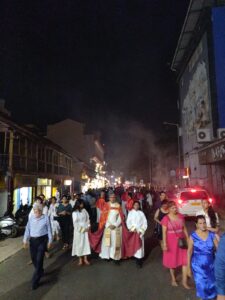
Confrades (Church confraternity members) wearing opa e murça (a red and white cape) carry the statue concertedly, giving the impression that it is floating on its own power. In the past, a brass band would follow; but nowadays, a choir sings from an intermediate landing of the church's zigzag stairway. The singing and prayers are heard throughout the route via funnel loudspeakers. The procession is animated by the recitation of five Sorrowful Mysteries of the Rosary until the end of the procession.
The circuit is marked by over ten descansos (halts), at which points the faithful flock to kiss the statue. A major halt happens at the Capela da Conceição (Chapel of the Immaculate Conception). Built in 1823, it was once a private chapel attached to the mansion of Dom Lourenço de Noronha, scion of a Portuguese noble family, and was later bequeathed to the Confrarias of Panjim church and has been under repairs since 2019.
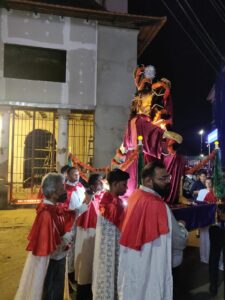
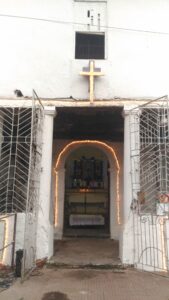
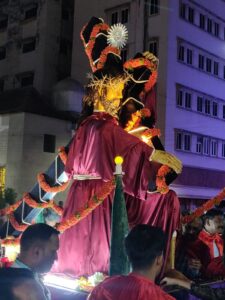
The cavalcade then proceeds via M. G. Road and Dr D. R. de Sousa, past the Garcia de Orta Garden, and up to the church square. Here, at the foot of the stairway, Jesus is met by His Blessed Mother. Sorrowing over her Son so unjustly accused and made to carry the Cross to His death, she accompanies him on his last last legs, as she did two thousand years ago to Golgotha.
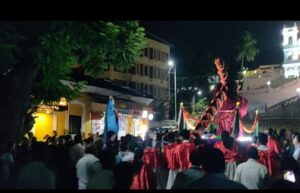
Soon thereafter, the two statues halt on the intermediate landing in front of a large cross carved out of the wall. A level higher, from a pulpit-like balcony jutting out of the said wall, a little girl unrolls the Veil of Veronica while she sings the traditional narrative. This is about the meeting of the legendary woman (feast day, 12 July) with Jesus. As recorded in the fourth station of the Via Crucis (Way of the Cross), Veronica, moved by the sight of Jesus carrying the Cross, wiped his brow with her handkerchief only to find a lasting imprint of his holy face on the cloth.
Thus ends Passion Sunday and preparations begin for the Holy Triduum beginning on the evening of Maundy Thursday. This day, which comprises a Mass with the reenactment of the historic Washing of the Feet by Jesus, marks the institution of the Eucharist and the Priesthood and the proclamation of the Commandment of Love. There is no public procession.
Five days later, on Good Friday, the processional arrangement is the same as on Passion Sunday, except for a few obvious differences.
The poignant Crucifixion tableau opens in the chancel at 3 o’clock in the afternoon. It is interesting how by then the sky is usually cloudy and the mood sombre. The liturgy of the Word and the Eucharist continue until at about half past five. Then, a procession of a larger-than-life-size statue of Senhor Morto (The Departed Lord) placed on an andor (black canopied wooden platform) starts off, with the statue of Our Lady in trail.

There are some other differences too. Today, the faithful are in funereal attire, which once upon a time was de rigueur. And instead of the sanctus bell, we hear the matraca or wooden rattle at every halt in the procession.
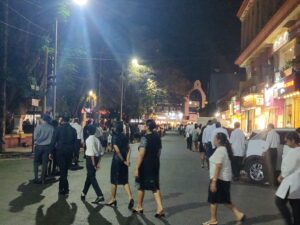
A major difference between the Passion Sunday and the Good Friday procession lies at their very end. This time round, in a coda to the baroque event, is the Sermão da Soledade de Maria (Sermon on the Solitude of Mary) delivered by a priest from the same pulpit-like balcony. The preacher extols the virtues of Mary and highlights her present solitude. Formerly, rhetoric played a crucial role on such occasions, helping to fully engage the congregation. Nowadays, the limited number of faithful who stay on to listen are easily distracted, not least by vehicle noises that detract from the solemn ambience.

In this context, one striking similarity between the processions is that both are watched in awe by people of other religions. On both occasions, residences put up decorative lights, candles or oil lamps in homage to Our Lord. Some non-Christian establishments remain open, it being a weekday, do the same. People from other religions watch in awe, including policemen (one of whom I saw standing at attention and saluting the Departed Lord). Particularly interesting is the case of the Caculos and the Neurencars, two Hindu families on Pissurlencar Street; they traditionally offer garlands of xenvtim or abolim.
Depending on the number of attendees, the pious, kilometre-long march and related ceremonies on both days take between 75 and 90 minutes. The statues return to the church for concluding rites and veneration. By 8 o’clock, they call it a night!
Behold two processional events in Panjim that have left a lasting imprint on my mind. So was it when my life began; so is it now I am a man. So be it when I grow old – for this ancient tradition is without a doubt one of the most moving spectacles in the religious and cultural calendar of my city, Panjim.
Requests:
1- In the comments section below, do share snippets of similar traditions in your village or city, and document them whenever possible.
2 - Do watch my video titled "Passion Sunday Procession in Panjim", on http://www.youtube.com/@oscardenoronha
Our Lord's saga of pain and suffering begins
LENT 2020 – Day 40
Readings: Is 50: 4-7; Ps 21: 8-9, 17, 18a, 19-20, 23-24; Phil 2: 6-11; Mt 26: 14-27, 66
The first two readings are a prologue to our Lord’s saga of pain and suffering described in the Gospel passage. Eight hundred years before Christ, prophet Isaiah anticipated the happenings on Calvary; and a millennium before Him, His ancestor King David wrote the haunting cry that the Christ crucified would utter: “My God, my God, why hast Thou forsaken me?” St Paul highlights the fact that the Son of God speaks here as “a servant, born in the likeness of men.” He underscores the humility and love with which our Lord looked at His earthly mission.
Today is commonly known as “Palm Sunday”. The evangelists have passages fit to commemorate this Sunday. Yet, the overarching theme of our Lord’s Passion takes precedence on this day, alternatively called “Passion Sunday”.
St Matthew portrays more than the story of a single day; he gives an overview of the first six days of the Holy Week. Accordingly, the passage comprises the entry of Jesus into Jerusalem on Sunday; His Passion on Thursday and finally His Death on that fateful Friday. However, in real time, Jesus’ last week on earth was packed with many other events as well. All together they precipitated the final meltdown, which soon became a watershed in world history.
With St Matthew as our guide
Let’s walk with St Matthew to see the places that Jesus visited, and why. Let’s also look at the personages that Jesus encountered on the way. They make up an eloquent portrait gallery in which you and I are sure to meet our human types.
When Jesus entered Jerusalem, He met an ecstatic lot. They spread garments and tree branches on the road, and shouted “Hosanna to the Son of David!” The city was stirred with the visit of “the prophet Jesus from Nazareth of Galilee”. Was this for real? Had Jerusalem accepted Him as their long-awaited Messiah? Well, this sudden switch of sentiments, this picture of innocence and goodness, seemed too good to be true. Thanks to human chemistry, an equal and opposite reaction gets underway in the minds and hearts of others following Jesus’ moves.
If the cheering multitude was naïve in its enthusiasm, so were Jesus’ disciples in their lack of fervour. On Thursday, they simply followed His instructions and arranged the Upper Room to hold their supper. Perhaps to them it was just another yearly feast. Did they understand what Jesus meant by saying that He would meet them again only “in my Father’s kingdom”? Ironically, only Judas Iscariot perhaps did, for he’d already conspired to sell his Lord for thirty pieces of silver.
That Wednesday night Jesus went out to the Mount of Olives to pray. He knew that His time was at hand. And knowing His sheep, too, He foretold that striking the shepherd would scatter them. To them it meant very little. Humans like us, lost in their own preoccupations, Peter, James and John fell asleep at three crucial moments. Curiously, here we see the human facet of Jesus too. Left to fend for Himself, he cried to His Father to let the cup pass if possible.
However, the human side of Jesus was soon superimposed with His superhuman dignity. When the kiss of betrayal brought in the hour, Jesus addressed Judas charitably as “friend”. And when someone cut off the ear of a soldier who had come to arrest Him, Jesus healed him instantly. What might the soldier have felt at that moment? What did he do thereafter: convert or continue his evil doing? We do not know. What we know, meanwhile, is that the disciples, the greatest beneficiaries of the magnanimous Jesus, took to their heels. What would we have done? And what do we do in the circumstances of our life today?
Next we meet old Caiaphas, yet another picture of human viciousness. He entertained a string of false testimonies. Then came the tipping point. Two witnesses reported that Jesus had declared that He could destroy the temple and rebuild it in three days. It no doubt crossed Caiaphas mind that Jesus was the Messiah but he didn't hail Him. Instead, he turned the tables on Him, crying “Blasphemy”, for which death was the punishment.
Jesus was next in the presence of Pilate, the governor. Here was a typical political figure playing to the gallery. He washed his hands and said, “I am innocent of this righteous man’s blood.” Why did he leave it to the populace to decide when he should have called a spade a spade? These are the undecided and/or the unconcerned who do everything only to save their skin…
At the praetorium, the stage was set for the final tragic act. Here we meet mockers. They stripped our Lord, and in disdain hung a scarlet robe over his body and a crown of thorns on his head. For a change, a man called Simon met Jesus as He wended his way to Calvary. Although they ordered him to help Jesus carry the Cross, he most likely did it with a measure of sympathy for the suffering Lord. Can we, like that Cyrenian, offer up our little sufferings as a humble participation in the carrying of the Cross?
At Calvary the ‘good thief’ said a good word to the dying Lord; he instantly merited Paradise. This goes to show that it’s never too late to convert. However, it’s better to be safe rather than sorry; we shouldn’t test God, as did Judas Iscariot, who stupidly lost his life in a shameful death.
After Jesus had died on the Cross, an old disciple, Joseph of Arimathea took charge of His sacred body. He wrapped the body in a clean linen shroud and laid it in his own new tomb. Like him, we too can help out, by rendering our services to the Bride of Christ. After all, the Church, which our Lord rebuilt on the third day, is the best repository of his memory. The Church also holds His three best gifts for humankind: first, the Holy Mass, held there every day as an unbloody enactment of the Holy Sacrifice on Calvary; second, the Priesthood, which He instituted as a sacrament of the New Covenant; and third, the commandment of love, a supreme example of how Jesus perfected the old law.
Our Lord Jesus Christ thus left us an invaluable heritage whereby we can become worthy candidates for eternal salvation. We will thereby vindicate His coming to the world.
